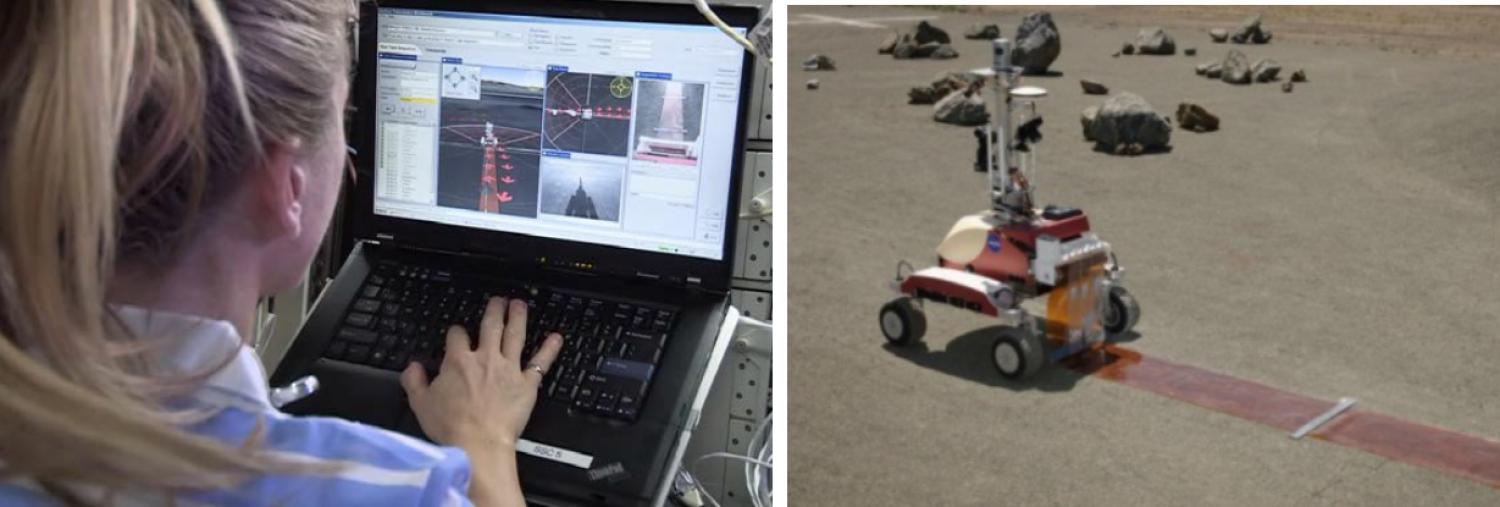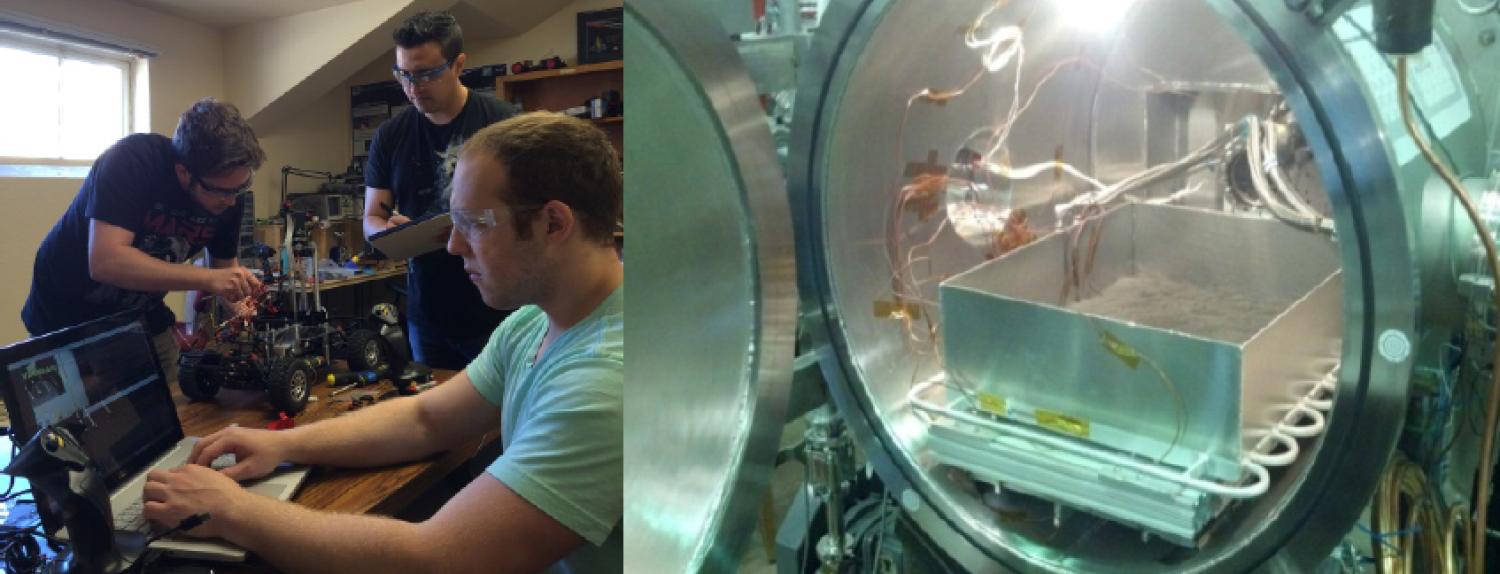Exploration enabled by Surface Telerobotics
Exploration Infrastructure
How can exploration infrastructure facilitate space science at target destinations?
Surface telerobotics will empower astronauts aboard Orion or an orbiting Habitat, as part of NASA’s Proving Ground, to remotely operate planetary surface assets for exploration and science. As NASA begins human expeditions beyond low Earth orbit (LEO) for the first time in half a century, exploration infrastructure will be a powerful enabler of decadal-caliber space science. In this first key project, we will develop tasks for a strategic technology that is required for new human explorations of the Moon and Mars. The maturation of surface telerobotics in cis-lunar space will feed-forward to the first human-orbiting Mars missions where crew will remotely supervise exploration/science planetary rovers with minimum latency. In collaboration with the NASA Ames Intelligent Robotics Group and Lockheed Martin’s (LM) Orion/Habitat program, we will develop the operational tools for surface telerobotics with specific science applications focused on the deployment of lunar low frequency radio arrays for heliophysics and astrophysics, respectively, and in conjunction with sample return missions from the South Pole-Aitken basin. Student training is a key element for this project - we will introduce undergraduate science, technology, engineering, and mathematics (STEM) students to systems engineering, mission design and operations, assembly of mechanical/electronic systems, and telerobotics software.

Telerobotics is a key technology for operating rovers on planetary surfaces with minimal latency. Here, astronaut Karen Nyberg, orbiting Earth on the ISS, teleoperates the K10 rover at NASA Ames and deploys a simulated lunar radio telescope array.
Telerobotic Deployment
What new systems should be added to Orion/Habitat, and what crew training strategies are needed to support telerobotic deployment of a low frequency telescope array?
With guidance from the International Space Station (ISS) telerobotics tests that we performed in 2014, we will carry out a collaborative project involving J. Burns and his students, T. Fong and his robotics group at Ames, and Lockheed Martin collaborators.
An analysis/trade study of what systems would have to be added to Orion or Habitat to support surface telerobotics will be conducted. This task will begin with a review of studies on data comms (hardware, link analysis, protocol) and operator control station (hardware and software) for Orion. The study will examine a variety of options including: minimal impact (using currently planned systems to the greatest extent possible), minimal addition (e.g., add a single "payload" computer), and full-up system (i.e., dedicated telerobotics setup like on ISS). This study will identify limitations of the various approaches and make preliminary sizing estimates (cost, software volume, power).
In terms of crew training strategies we will begin an in-depth survey of operator training methods (spanning manual control to supervisory control) across a range of application domains (i.e., not just space). Then, we will perform an analysis of possible cis-lunar missions to understand how/when telerobotics could be employed (e.g., in terms of activity frequency, duration) and planned methods for crew training. Finally, we will develop training strategies that may be useful for telerobotics, taking into consideration ground control and robot control modes.
Operational Requirements
What are the operational requirements for deployment of radio antenna arrays from landers and rovers, possibly in conjunction with an astronaut-assisted lunar sample return?
In terms of the analysis of lunar radio telescope deployment and operational requirements an end-to-end analyses of the tasks that must be carried out telerobotically to deploy and maintain a lunar telescope will be constructed. We will mature the concept from our ISS simulations into what really would have to be done, in what order, with what level of accuracy, handling what types of contingencies, etc. We will assess the data communication needs (data rate, transmit frequencies, receiver requirements and trades of L2 vs. distant retrograde orbit for a Habitat). As part of this study, we will incorporate the results of the astrophysics and heliophysics radio array trade studies to examine the deployment requirements for different array topologies.
To investigate the requirements for landers and to advance the telerobotic deployment of radio arrays, we will examine the requirements for three specific lander concepts. First, we will investigate deployment of a radio array from an SPA sample-return lander using MoonRise as a design reference mission. One concept is the emplacement of a compact array on the lunar surface using an inflation system. Second, we will work on deployment strategies with Moon Express (ME) and Co-Investigator Currie, who has contracted with ME to land 4 LLR corner cubes, to deploy a radio array from their lander. Finally, we will develop requirements with collaborators Koopmans and Falcke for the deployment of a low frequency telescope from the proposed ESA lunar lander mission FARSIDE3.
For radio array deployment in conjunction with astronaut-assisted sample return, we have partnered with SSERVI Principle Investigator D. Kring in developing a concept for a proving ground mission to teleoperate a rover on the lunar farside from E-M L2. We will place an unmanned lander within the Schrödinger basin which has been noted as geologically rich; a sample return, facilitated via Orion, would address many of the scientific goals in the NRC. In this task, we will collaborate with Kring’s team to investigate the rover requirements to both gather geological samples and to deploy a radio telescope array: e.g., payload requirements, timing of array deployment, defining the minimum distance from the sample-return vehicle, and rover controls for sample collection and telescope deployment.
Surface telerobotics and student-built teleoperated rover systems will be developed with funding from NLSI, Lockheed Martin, and Principle Investigator J. Burns’ student teams have built teleoperated rover systems where STEM students gain experience in the design, construction, and remote operation of planetary rovers. The students investigate the impact of limited bandwidth, latency, and sensor parameters (e.g., video quality) on remote operations.
Effective Student Training
How do telerobotic laboratory simulations improve the realism and effectiveness of student training?
Our student engagement and education effort will encompass a broad range of robotic exploration topics, including lunar analog terrain to test operational factors and a thermal vacuum lunar simulation chamber.
We will develop a lunar analog terrain, which will be built with support from University of Colorado's Facilities/Maintenance Office. An outdoor site, which contains a variety of terrain features and rocky soil that can serve as a low-fidelity lunar terrain proxy. Students will develop a robust rover that is capable of exploring the lunar analog terrain. In this work, our objective is to expose students to the key aspects of planetary rover design (including locomotion, power, navigation, etc.) and remote operation (user interface, control modes, etc.). With the new rover and lunar analog terrain, the student team will design a new experiment to test operational factors to further improve situational awareness (e.g. effects of changing the video bandwidth). We will run this experiment with a small number of participants, but a large number of trial runs to allow us to make statistically significant conclusions. The results from this test will be reported at the SSERVI Exploration Science Forums and will be submitted for publication in a student research journal. Additionally, our student-operated thermal-vacuum chamber facility at CU will be used to test rover components, antenna materials, and receiver electronics in simulated day/night lunar conditions.

NESS provides realistic, advanced laboratory experiences for science & engineering undergraduates to design, build, and operate teleoperated rovers (left) and to conduct experiments in a simulated lunar environment consisting of thermal-vacuum chambers with lunar simulants (right).

